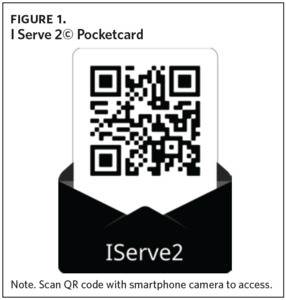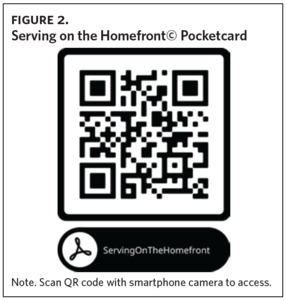Introduction
Military families have endured multiple stressors in support of their Service Members’ engagement in the wars in Iraq and Afghanistan over the past 20 years. Despite those conflicts ending, military families continue to face challenges. It is important that those who care for those who serve understand the unique needs of military families, especially pertaining to their physical and psychological health. Failure to do so could have serious implications, not only on the health and well-being of the military family, but also on United States national security.
It is imperative that civilian providers have the knowledge and confidence to meet the needs of the entire military family and ensure they have access to quality care. Furthermore, the care received should be culturally competent and inclusive of the entire military family unit, focused on identifying risks associated with spousal/parental military service, including incorporation of the social determinants of health as they relate to the military lifestyle. This can be accomplished through asking the question, “Do you have a family member who has served?” and understanding the risks associated with the military lifestyle, as well as conducting a culturally competent health history and physical exam, and knowing what resources and referrals are available in the community.1
Background
Service Members and their families live in communities across the United States and around the globe. The US military is comprised of approximately 1.34 million active-duty Service Members, 793,808 Reserve/National Guard forces, 948,365 military spouses, and 1.61 million military-connected children.2 Roughly 50% of Service Members serving on active duty or in the Reserve or National Guard are married, and upwards of 39% have at least one child.2 North Carolina has the fourth-highest military population in the United States, after California, Texas, and Florida, and is home to 12 military installations.3 While every county in the state of North Carolina has military-connected residents, Cumberland and Onslow counties have the largest numbers of Veterans, Service Members, and/or military-connected family members residing in their communities.3 Health care providers within community settings need to understand the unique needs, risks, and exposures impacting military-connected family members in order to appropriately tailor care.
Military families live with a sense of pride and patriotism regarding the role their families play in providing for the safety and security of the country.1 Active-duty military family members experience many positive opportunities related to the military lifestyle, including traveling and living in locations around the globe, immersing themselves in diverse cultures, meeting new people, being able to reinvent themselves with each move, and accessing the many resources available to them in the military and civilian community. Reserve and National Guard families also experience many positives, though the families of Reserve and National Guard forces are typically less likely to move, have less disruptions in school and health care services, and maintain connections with friends and family members long term. However, Reserve and National Guard families may live quite a distance from their duty site and do not have access to the many resources available on a military installation. Despite the positive aspects associated with active-duty, Reserve, and National Guard service, risks still occur that can negatively impact the health and well-being of the military family.
When service-connected families have negative experiences, they encounter critical second- and third-order consequences. Military family members play an important role in the security of the nation; the top predictor of a Service Member remaining in the military is the overall satisfaction of the military spouse and the perceived toll of the military life on them and their children.4 When the cost of recruiting and training Service Members and the legacy of multigenerational family service are factored in, it is important to remember that disenfranchising military family members can impact national security through attrition. This happens through lack of reenlistment and/or separating, as well as a failure to meet recruiting quotas at a time when less than 23% of individuals aged 18–24 can qualify for military service due to obesity, incarceration, physical and/or mental health concerns, and other issues.4
Health Care Needs
Military-connected families live with unique circumstances that contribute to and shape their health care needs. While many military-connected individuals have access to health care via some version of TriCare (the Department of Defense’s health insurance plan), access does not necessarily equate to quality or tailored care. Frequent moves by families lead to frequent turnover/lack of care continuity with military-based providers, lack of specialty care, and difficulty accessing service-related screenings.5 These families also often obtain care in communities by providers outside of military bases and posts. Therefore, providers need to be prepared to meet the unique needs of these populations.
Military Health Care Context
TriCare provides insurance coverage for active-duty military family members and retirees but not non-activated National Guard or Reservists. Historically, Military Treatment Facilities (MTFs) have provided primary care, and where available specialty care, to Service Members, families, and retirees. In 2016, the Military Health System proposed to improve the readiness of Service Members by focusing care provided at MTFs on active-duty Service Members, which led to contracting of care for dependents into the civilian sector. Now, active-duty family members receive care in civilian health care facilities.6 The families of Veterans and Reserve and National Guard forces may not have or use TriCare, and typically receive 100% of their care in civilian health care facilities. This means that more military-connected families will seek care from civilian providers who may be unaware of their patients’ connection to the military and the risks and exposures secondary to that military connection. In a survey, roughly 25% of health care providers in New York had worked or trained in the Veterans Administration or a military treatment facility, less than a third of respondents stated understanding of the military culture, and only 2.3% of providers met all the criteria for providing culturally competent care to Veterans in their practices.7 In North Carolina, with approximately 700,000 Veterans, 98,000 active duty, and 21,000 National Guard/Reservists and their families, clinicians are taking care of military-connected individuals, they just may not know it.8,9
To aid civilian and community-based providers, “I Serve 2” and the “Serving on the Homefront” pocket cards have been developed to assist with assessment, screening, and follow-up of military-connected children, spouses, partners, and caregivers.
I Serve 2© —An Initiative Focused on Military-connected Children
I Serve 2: A Pocketcard for Healthcare Providers Caring for Military Children© was created to serve as an aid for health care providers when caring for military-connected children.10 The pocket card prompts the provider to ask the question, “Do you have a parent, sibling, or other family member who has ever served in the military?” If the answer is yes, there are prompts to determine the military member’s status, when and where the Service Member was deployed, and to ascertain where the military family is in the deployment cycle and/or the relocation cycle. The ICARE (Identify, Correlate, Ask, Ready Resources, and Encourage and Educate) Support Strategy for Military Children and question prompts provide guidance to providers during the health history and anticipatory guidance phase of the patient encounter. In addition, there is guidance for vulnerability and risk assessments to screen for personal safety, depression, anxiety, suicidality, and topics like food and housing insecurity, as well as links to national resources for providers and parents/patients. Scan the QR code in Figure 1 with your phone’s camera to access the pocket card.
Serving on the Homefront©—Addressing the Needs of Military-connected Spouses, Partners, and Caregivers
Spouses and partners of Service Members have an idiosyncratic role in military life and culture. The military defines where they live, how long they will live there, how much access they will have to their Service Member, and how much they will ever know about what their partner does to earn a paycheck. The military does not confer any employment, education, or benefit directly to spouses.10 In this system, spouses are labeled as “dependents.” Yet, these same spouses are often managing frequent moves, raising children, and caring for parents while caring for their Service Member and maintaining a career or getting an education. This context is why health care providers need to overtly screen for social determinants of health with these partners. The Serving on the Homefront© pocket card is categorically aligned with the I Serve 2© pocket card. For spouses, the areas for assessment are focused on the military-lifestyle-specific determinants of health that can impact care. For example, a patient new to a practice may not be able to say when their last Pap test was, or remember the result. Assessing that she is a military spouse, the clinician may find that this is due to a move followed quickly by deployment and a young child with chronic health care needs, or the previous military clinic not being able to find her records. She may not have prioritized routine primary care or specialty referrals. Thorough assessment is critical with these patients. Scan the QR code in Figure 2 with your phone’s camera to access the pocket card.
Reserves and National Guard
Reserve and National Guard families are too often invisible in their communities. There is a mistaken idea that with the cessation of conflicts in Iraq and Afghanistan, all deployments have ceased. Nothing could be further from the truth. Routine deployments are ongoing in all branches of service, in all parts of the world, every day. Reserve and National Guard Service Members are still being called into active duty. At that point, their families become military families, with a change in insurance, finances, and parent/partner availability. Providers who are not in proximity to military bases or posts cannot assume that they do not have military-connected families in their practices. Additionally, what is known about military-connected children cannot be assumed to be applied to Reserve-connected (RC) children because there is a paucity of information about the experiences and needs of the latter.11 North Carolina’s Department of Military and Veterans Affairs routinely updates and publishes a guide to local and regional resources that support military Service Members, Veterans, and their families at https:// www.milvets.nc.gov/. Additionally, NCServes (https:// nccare360.org/ncserves/) is a single site connected to the statewide network NCCARE360 that allows users to search for resources for Service Members, Veterans, and connected families. However, services for RC individuals and families are not explicated overtly.
Summary
In the era of value-based care and precision medicine, quality care is determined by our ability to assess and take into account context and presenting need. The first step in caring for those who serve is to assess their military connections. Once they are identified, then a thorough screening for risks and establishment of quality care can take place.
Disclosure of interests
Drs Ling and Rossiter have no funding or conflict of interests to report. The ideas and content put forth here do not reflect the positions or policy of the US Department of Defense or the US Government.




